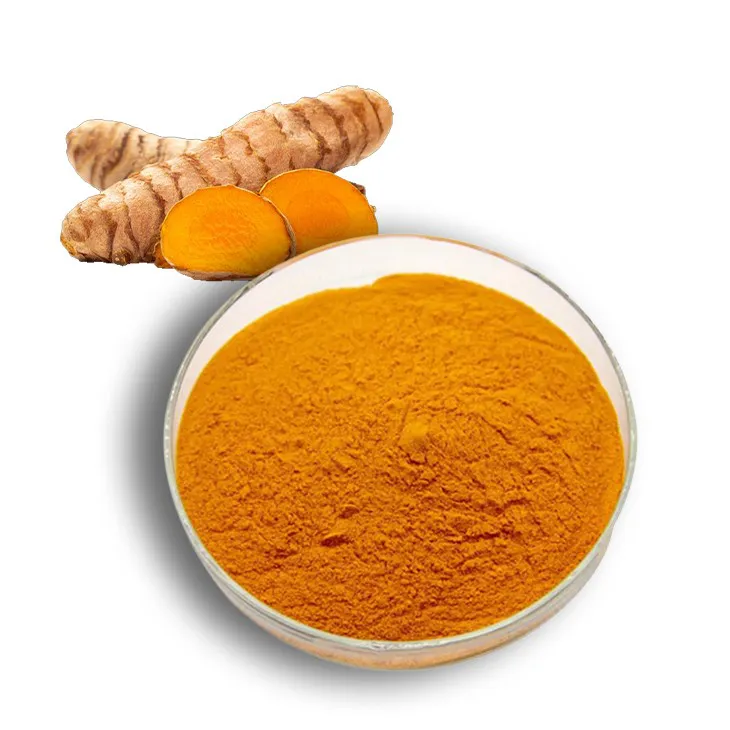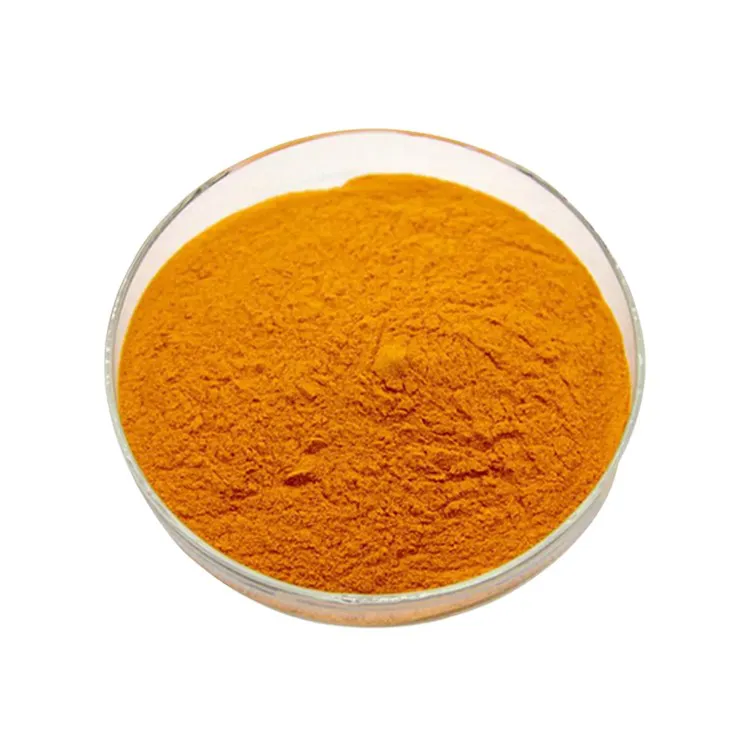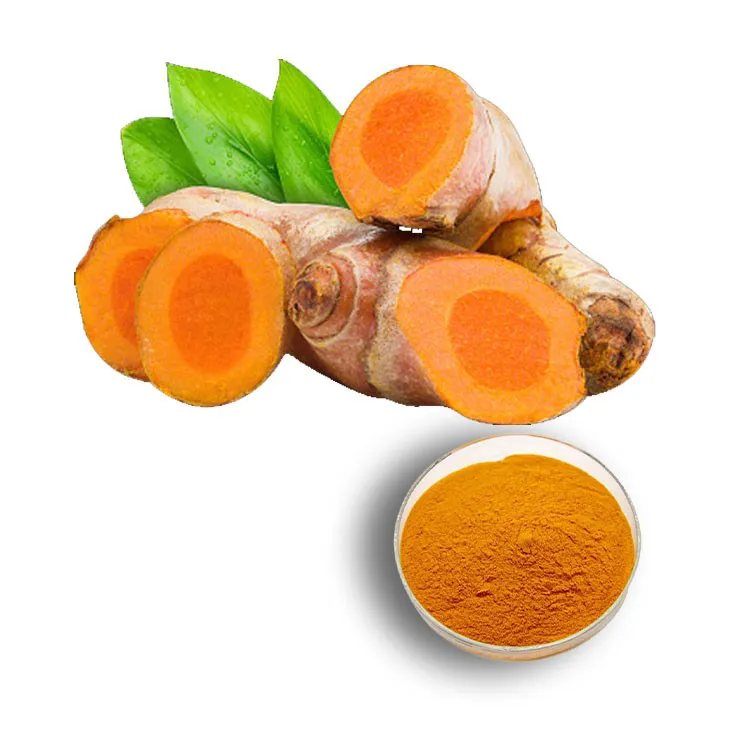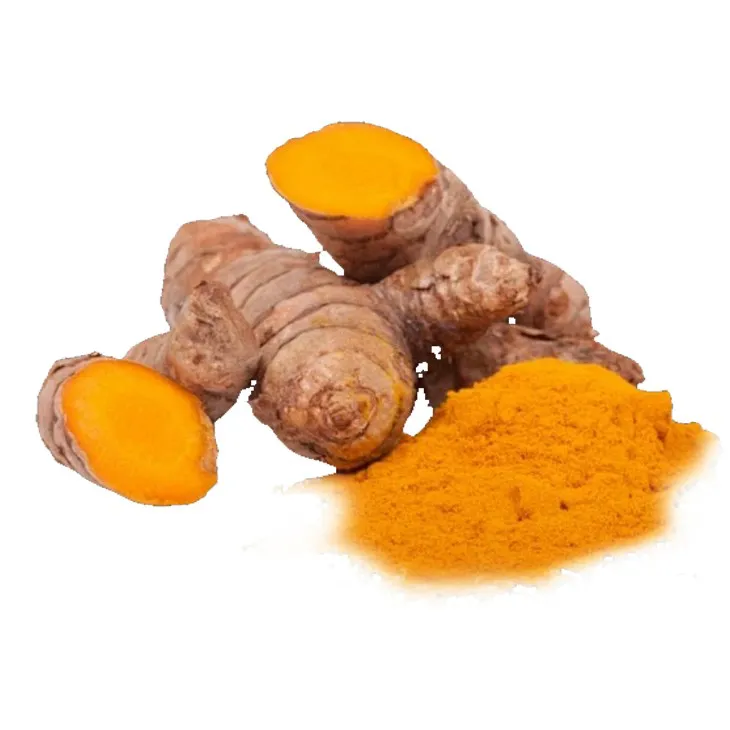- 0086-571-85302990
- sales@greenskybio.com
Curcumin
2024-11-11

1. Introduction
Curcumin is a bioactive compound that has captured substantial attention in recent times. It is a yellow - colored pigment predominantly found in turmeric. Turmeric has been used for centuries in traditional medicine, especially in Asian cultures, and Curcumin is now being recognized globally for its numerous health - related properties.

2. Biological Activities
2.1 Antioxidant Activity
Curcumin is a potent antioxidant. It has the ability to neutralize reactive oxygen species (ROS) and reactive nitrogen species (RNS). ROS and RNS are produced in the body during normal metabolic processes, but their overproduction can lead to oxidative stress. Oxidative stress is associated with a variety of diseases, including cancer, cardiovascular diseases, and neurodegenerative disorders. By scavenging these reactive species, curcumin helps in maintaining cellular homeostasis. Cellular homeostasis is the state of stable internal, physical, and chemical conditions maintained by living systems. Curcumin's antioxidant capacity is crucial for protecting cells from damage caused by free radicals. For example, in vitro studies have shown that curcumin can prevent lipid peroxidation, which is a process that can damage cell membranes due to oxidative stress.
2.2 Anti - inflammatory Function
Curcumin can target multiple molecular targets involved in the inflammatory process. Inflammation is a complex biological response of the body to harmful stimuli, such as pathogens, damaged cells, or irritants. One of the key aspects of curcumin's anti - inflammatory action is its ability to down - regulate the expression of cyclooxygenase - 2 (COX - 2) and inducible nitric oxide synthase (iNOS). COX - 2 is an enzyme that is up - regulated during inflammation and is responsible for the production of prostaglandins, which are lipid - based mediators that promote inflammation. iNOS is another enzyme that produces nitric oxide, which can also contribute to the inflammatory response at high levels. By reducing the expression of these enzymes, curcumin can effectively dampen the inflammatory process.
In the context of specific diseases, for instance, in rheumatoid arthritis, which is an autoimmune and inflammatory disease, curcumin has shown potential in reducing joint inflammation. Studies have demonstrated that curcumin can inhibit the production of pro - inflammatory cytokines, such as interleukin - 1β (IL - 1β) and tumor necrosis factor - α (TNF - α), which play important roles in the pathogenesis of rheumatoid arthritis.
2.3 Role in Dermatology
In the field of dermatology, curcumin has been explored for its potential in treating skin diseases. Psoriasis is a chronic skin disease characterized by abnormal immune - mediated inflammation in the skin. Curcumin can modulate the immune response in the skin, which makes it a promising candidate for psoriasis treatment. It can regulate the activity of immune cells in the skin, such as T - lymphocytes, which are involved in the inflammatory process in psoriasis.
Additionally, curcumin has antioxidant properties that can also be beneficial for skin health. It can protect the skin from damage caused by ultraviolet (UV) radiation. UV radiation can generate ROS in the skin, leading to oxidative stress and skin damage. Curcumin's antioxidant capacity can neutralize these ROS, thereby reducing the risk of skin aging, sunburn, and potentially skin cancer.
2.4 Influence on Metabolism
Curcumin may play a role in improving insulin sensitivity. Insulin sensitivity refers to how responsive the body's cells are to the hormone insulin. In individuals with insulin resistance, cells do not respond properly to insulin, leading to high blood sugar levels. Curcumin has been shown to regulate various pathways involved in insulin signaling. For example, it can enhance the activity of insulin receptor substrate - 1 (IRS - 1), which is an important protein in the insulin signaling cascade.
In terms of lipid metabolism, curcumin has potential benefits. It can influence lipid biosynthesis and metabolism in the liver. Studies have suggested that curcumin may reduce the synthesis of triglycerides and cholesterol in the liver, thereby potentially reducing the risk of obesity - related diseases, such as non - alcoholic fatty liver disease (NAFLD) and atherosclerosis. Obesity is often associated with abnormal lipid metabolism, and curcumin's ability to regulate lipid metabolism makes it an interesting compound for the prevention and treatment of obesity - related metabolic disorders.
2.5 Anti - microbial Properties
Curcumin's anti - microbial properties have also been investigated. It has been shown to inhibit the growth of certain bacteria, fungi, and viruses.
- Bacteria: Curcumin can disrupt the cell membranes of bacteria. For example, it has been shown to be effective against some Gram - positive and Gram - negative bacteria. In the case of Staphylococcus aureus, a common Gram - positive bacterium that can cause various infections, curcumin can interfere with its cell membrane integrity and inhibit its growth.
- Fungi: Curcumin has antifungal activity as well. It can affect the growth and survival of fungi by interfering with their cellular processes. For instance, in Candida albicans, a common fungal pathogen, curcumin can disrupt its cell wall synthesis and mitochondrial function, leading to growth inhibition.
- Viruses: Regarding viruses, curcumin has been shown to have antiviral activity against some viruses. Although the exact mechanisms are still being explored, it is thought that curcumin may interfere with viral entry into host cells or viral replication processes. For example, some studies have suggested that curcumin may have potential against herpes simplex virus (HSV) by inhibiting its replication.

3. Absorption, Distribution, Metabolism, and Excretion (ADME) of Curcumin
Understanding the ADME profile of curcumin is important for its potential therapeutic applications.
- Absorption: Curcumin has relatively poor oral absorption. This is due to its low solubility in water and its rapid metabolism in the gut and liver. Only a small fraction of orally administered curcumin is actually absorbed into the bloodstream. However, various strategies have been developed to improve its absorption, such as using lipid - based formulations or combining it with other substances that can enhance its solubility.
- Distribution: Once absorbed, curcumin is distributed to various tissues in the body. It has been detected in the liver, spleen, kidney, and brain, among other organs. However, its distribution may be limited by factors such as its binding to plasma proteins and its ability to cross biological membranes.
- Metabolism: Curcumin is extensively metabolized in the body. It undergoes phase I and phase II metabolism in the liver. In phase I metabolism, curcumin is mainly hydroxylated, and in phase II metabolism, it is conjugated with glucuronic acid or sulfate. These metabolic processes can affect its bioavailability and biological activity.
- Excretion: The metabolites of curcumin are mainly excreted in the feces, with a small amount excreted in the urine. The rapid metabolism and excretion of curcumin can limit its effectiveness as a therapeutic agent, but ongoing research is focused on developing strategies to overcome these limitations.

4. Clinical Studies and Therapeutic Applications
- Cancer: In cancer research, curcumin has been studied for its potential anti - cancer properties. Some in vitro and in vivo studies have shown that curcumin can inhibit the growth and proliferation of cancer cells. It can induce apoptosis (programmed cell death) in cancer cells, and it can also inhibit angiogenesis, which is the process by which new blood vessels are formed to supply nutrients to tumors. However, the translation of these pre - clinical findings into effective cancer treatments has been challenging due to issues such as curcumin's poor bioavailability. Clinical trials are ongoing to evaluate the efficacy of curcumin in combination with other anti - cancer drugs or therapies.
- Cardiovascular Diseases: For cardiovascular diseases, curcumin's antioxidant and anti - inflammatory properties make it a potential therapeutic agent. It may help in reducing oxidative stress and inflammation in the blood vessels, which are important factors in the development of atherosclerosis. Some small - scale clinical studies have suggested that curcumin supplementation may improve endothelial function, which is crucial for maintaining normal blood vessel function. However, more large - scale, long - term clinical trials are needed to confirm these findings.
- Neurological Disorders: In the context of neurological disorders, such as Alzheimer's disease and Parkinson's disease, curcumin has also been investigated. These diseases are associated with oxidative stress, inflammation, and abnormal protein aggregation in the brain. Curcumin's antioxidant and anti - inflammatory properties may help in protecting neurons from damage. Some pre - clinical studies have shown promising results, but again, clinical trials are required to determine its effectiveness in humans.
- Metabolic Syndrome: Given curcumin's effects on metabolism, it has been studied in the context of metabolic syndrome. Metabolic syndrome is a cluster of conditions that include insulin resistance, high blood pressure, abnormal lipid levels, and abdominal obesity. Curcumin may help in improving some of these parameters, such as insulin sensitivity and lipid metabolism. Clinical trials are ongoing to evaluate its potential in the management of metabolic syndrome.

5. Safety and Toxicity of Curcumin
Curcumin is generally considered safe when consumed in amounts typically found in food. However, when used in high - dose supplements, some potential side effects need to be considered.
- Gastrointestinal Issues: High - dose curcumin supplementation may cause gastrointestinal side effects, such as nausea, diarrhea, and abdominal discomfort. These effects are likely related to its impact on the digestive system.
- Interactions with Medications: Curcumin may interact with certain medications. For example, it can affect the metabolism of drugs that are metabolized by cytochrome P450 enzymes in the liver. This can potentially lead to changes in the effectiveness or toxicity of these medications. Therefore, it is important for patients taking medications to consult their healthcare providers before starting curcumin supplementation.
- Allergic Reactions: Although rare, some individuals may be allergic to curcumin. Allergic reactions can range from mild skin rashes to more severe anaphylactic reactions. People with a known allergy to turmeric or related substances should avoid curcumin - containing products.

6. Conclusion
Curcumin is a bioactive compound with a wide range of biological activities, including antioxidant, anti - inflammatory, effects on metabolism, anti - microbial properties, and potential therapeutic applications in various diseases. However, its poor bioavailability and potential side effects at high doses need to be addressed. Ongoing research is focused on developing new formulations to improve its absorption and effectiveness, as well as conducting more clinical trials to fully understand its therapeutic potential. With further research, curcumin may become an important component in the prevention and treatment of a variety of diseases in the future.
FAQ:
What are the main sources of curcumin?
Curcumin is mainly found in turmeric, which is a common spice. Turmeric contains a significant amount of curcumin, making it the primary natural source of this bioactive compound.
How does curcumin act as an antioxidant?
Curcumin acts as an antioxidant by being capable of neutralizing reactive oxygen species (ROS) and reactive nitrogen species (RNS). This helps in maintaining cellular homeostasis as it counteracts the harmful effects of these reactive species, which can otherwise cause oxidative stress and damage to cells.
What is the significance of curcumin's anti - inflammatory function?
The significance of curcumin's anti - inflammatory function lies in its ability to target multiple molecular targets in the inflammatory process. By down - regulating the expression of key enzymes like cyclooxygenase - 2 (COX - 2) and inducible nitric oxide synthase (iNOS), it can reduce inflammation. This is important in various diseases where inflammation plays a major role, and can also have potential applications in treating conditions such as psoriasis in dermatology.
How can curcumin improve insulin sensitivity?
While the exact mechanisms are still being explored, curcumin has been shown to play a role in improving insulin sensitivity. It may interact with certain cellular pathways involved in glucose metabolism and insulin signaling. Additionally, its role in regulating lipid metabolism might also contribute to better insulin sensitivity, potentially reducing the risk of obesity - related diseases.
What are the anti - microbial properties of curcumin?
Curcumin has been shown to have anti - microbial properties. Evidence suggests that it can inhibit the growth of certain bacteria, fungi, and viruses. However, the exact mechanisms of action against different microbes may vary. For example, it might disrupt the cell membranes of bacteria or interfere with the replication processes of viruses.
Related literature
- The Multifaceted Therapeutic Potential of Curcumin in Disease Prevention and Treatment"
- "Curcumin: A Review of Its' Effects on Human Health"
- "Biological Activities and Therapeutic Potential of Curcumin"
- ▶ Hesperidin
- ▶ Citrus Bioflavonoids
- ▶ Plant Extract
- ▶ lycopene
- ▶ Diosmin
- ▶ Grape seed extract
- ▶ Sea buckthorn Juice Powder
- ▶ Fruit Juice Powder
- ▶ Hops Extract
- ▶ Artichoke Extract
- ▶ Mushroom extract
- ▶ Astaxanthin
- ▶ Green Tea Extract
- ▶ Curcumin
- ▶ Horse Chestnut Extract
- ▶ Other Product
- ▶ Boswellia Serrata Extract
- ▶ Resveratrol
- ▶ Marigold Extract
- ▶ Grape Leaf Extract
- ▶ New Product
- ▶ Aminolevulinic acid
- ▶ Cranberry Extract
- ▶ Red Yeast Rice
- ▶ Red Wine Extract
-
Passionflower Extract
2024-11-11
-
Rosemary extract
2024-11-11
-
Angelica sinensis extract
2024-11-11
-
Yellow Pine Extract
2024-11-11
-
Golden Seal Extract
2024-11-11
-
Bamboo Leaf extract
2024-11-11
-
Nettle Root Extract
2024-11-11
-
Green coffee bean Extract
2024-11-11
-
Senna Leaf Extract
2024-11-11
-
Chasteberry Extract
2024-11-11





















